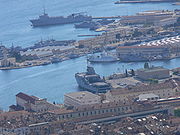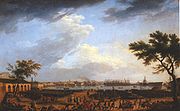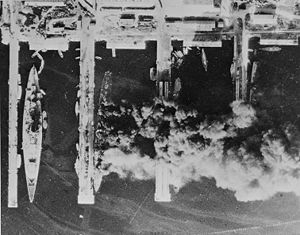
Military port of Toulon
Encyclopedia


French Navy
The French Navy, officially the Marine nationale and often called La Royale is the maritime arm of the French military. It includes a full range of fighting vessels, from patrol boats to a nuclear powered aircraft carrier and 10 nuclear-powered submarines, four of which are capable of launching...
, sited in the city of Toulon
Toulon
Toulon is a town in southern France and a large military harbor on the Mediterranean coast, with a major French naval base. Located in the Provence-Alpes-Côte-d'Azur region, Toulon is the capital of the Var department in the former province of Provence....
. It holds most of France's force d'action navale
Force d'Action Navale
The Force d'action navale is the 12,000-man and about 100-ship strong backbone of the French Navy. As of 2006, it is commanded by Vice-Amiral d’Escadre Philippe Sautter.The ships are divided into seven categories:...
, comprising the aircraft carriers Charles de Gaulle
Charles de Gaulle (R 91)
Charles de Gaulle is the flagship of the French Navy and the largest Western European aircraft carrier. She is the tenth French aircraft carrier, the first French nuclear-powered surface vessel, and the first and so far only nuclear-powered carrier completed outside of the United States Navy...
as well as its nuclear attack submarines, in total more than 60% of the tonnage of the French Navy.
History


La Seyne-sur-Mer
La Seyne-sur-Mer, or La Seyne is a commune in the Var department in the Provence-Alpes-Côte d'Azur region in southeastern France. It is part of the agglomeration of Toulon, and is situated adjacent to the west of this city.-Economy:...
, as well as the arsenal, or military port of Toulon, and the commercial port.
The 'modern' history of the port begins when Louis XII built his Tour Royale
Tour Royale, Toulon
The Tour Royale is a fort built in the 16th century to protect the entrance of the Petit Rade, the naval port of Toulon. It was the first fortification of the harbor, built 22 years after Provence became a part of France....
at Toulon in 1514. A naval arsenal and shipyard was built in 1599, and small sheltered harbour, the Veille Darse, was built in 1604-1610 to protect ships from the wind and sea. The shipyard was greatly enlarged by Cardinal Richelieu, who wished to make France into a Mediterranean naval power. In 1680, Jean-Baptiste Colbert
Jean-Baptiste Colbert
Jean-Baptiste Colbert was a French politician who served as the Minister of Finances of France from 1665 to 1683 under the rule of King Louis XIV. His relentless hard work and thrift made him an esteemed minister. He achieved a reputation for his work of improving the state of French manufacturing...
, the Minister of the Navy and Controller of Finance of King Louis XIV, began building a much larger port, called the Darse Vauban or the Darse Neuve, and shipyard, designed by his commissioner of fortifications, Vauban
Vauban
Sébastien Le Prestre, Seigneur de Vauban and later Marquis de Vauban , commonly referred to as Vauban, was a Marshal of France and the foremost military engineer of his age, famed for his skill in both designing fortifications and breaking through them...
.
In 1697, Vauban
Vauban
Sébastien Le Prestre, Seigneur de Vauban and later Marquis de Vauban , commonly referred to as Vauban, was a Marshal of France and the foremost military engineer of his age, famed for his skill in both designing fortifications and breaking through them...
built the impressive corderie, a building designed to make ropes. The corderie, still standing, is 20 metres wide and 320 metres long, built so that ropes could be stretched the entire length of the building as they were twisted together. Power for the ropemaking was provided by convicts from the adjoining prison, who walked in an enormous treadmill. A triumphal gate (now the Museum of the Navy) was added to the Arsenal in 1738.
The Arsenal port was enlarged still further in the 19th century and the 20th century. The construction of the arsenal du Mourillon
Le Mourillon
Le Mourillon is a small seaside neighborhood to the east of the French city of Toulon, near the entrance to the Rade or roadstead. It was once a fishing village, and then became the home of many of the officers of the French fleet and to part of the naval dockyard. Mourillon has a small fishing...
began at the start of the 18th century, as an extension of the major Toulon arsenal on the roadstead's east coast. Until the 20th century this extension held stores for the wood to build the French Navy. From the late 19th century it was this shipyard that built France's first ironclad frigates then the world's first modern submarines.

Scuttling of the French fleet in Toulon
The French fleet in Toulon was scuttled on 27 November 1942 on the order of the Admiralty of Vichy France to avoid capture by Nazi German forces during Operation Lila of the Case Anton takeover of Vichy France.- Context :...
itself on 27 November 1942 on the orders of the French admiralty. During the 20th century the Mourillon arsenal was mainly dedicated to submarine activity as a French submarine base until 1940, then a German one from 1940 to 1945, then a dockyard and torpedo factory after 1945. The Arsenal was badly damaged by Allied bombing in World War II, but since has been reconstructed and modernised. It has eleven drydocks for ship repair, the two largest of which are 422 metres by 40 metres. The Arsenal is still the principal military port of France, the home port of the aircraft carrier Charles de Gaulle (R91), France's attack submarine squadron
Submarine forces (France)
The submarine forces of France is the submarine component of the French Navy.It is a self-sufficient command - providing the maintenance and support of its own vessels - served by 3,300 personnel and made up of two components:*the force océanique stratégique , made up of four ballistic missile...
, and the other ships of the French Mediterranean fleet.
The Arsenal is not open to the public, but the Naval Museum at its entrance has a remarkable collection of enormous ship models from the 18th century, used to train the heir to the throne in seamanship, as well as other naval memorabilia. The building of the Corderie can be seen beside the road nearby. Boat tours depart regularly from the waterfront, and allow visitors to have a good look at ships of the French fleet.
Main infrastructures

- Castigneau ;
- Malbousquet ;
- Missiessy ;
- Milhaud.
The first has two main entrances :
- next to the civil port - the main gate, adjoining the musée de la marine whose façade, classed as a monument historiqueMonument historiqueA monument historique is a National Heritage Site of France. It also refers to a state procedure in France by which national heritage protection is extended to a building or a specific part of a building, a collection of buildings, or gardens, bridges, and other structures, because of their...
, is the predecessor to this new gate. The new gate is located next to the arsenal's quai d'honneur and the monumental façade of the Mediterranean maritime préfecture, flanked by cannons and gilding. - at the west entrance to Toulon town-centre - more practical than the other entrance (it is less than 200m from an autoroute exit onto four roads), it ensures freight and civil and military convoys from the base can flow freely.
The three other gates are secondary and little used, though still heavily guarded. To the extreme west in the communes of La Seyne-sur-Mer
La Seyne-sur-Mer
La Seyne-sur-Mer, or La Seyne is a commune in the Var department in the Provence-Alpes-Côte d'Azur region in southeastern France. It is part of the agglomeration of Toulon, and is situated adjacent to the west of this city.-Economy:...
and Ollioules
Ollioules
Ollioules is a commune in the Var department in the Provence-Alpes-Côte d'Azur region in southeastern France.-Twin townss:Ollioules is twinned with: Weiler-Simmerberg, Germany, since 2004-2005-References:*Notes...
the military base is in contact with the commercial port of Brégaillon, connected to national and regional networks for the supply of artillery munitions and other supplies.
The arsenal du Mourillon, next to the roadstead, is directly accessible via the north arsenal which housed a submarine base until 1945. The south arsenal is accessed by the small slipway of Le Mourillon
Le Mourillon
Le Mourillon is a small seaside neighborhood to the east of the French city of Toulon, near the entrance to the Rade or roadstead. It was once a fishing village, and then became the home of many of the officers of the French fleet and to part of the naval dockyard. Mourillon has a small fishing...
beside the now-disappeared torpedo factory.
Roads and railways
The military bases possesses more than 30 km of roads, railway level crossings, traffic lights, signs, etc.. It also has an SNCFSNCF
The SNCF , is France's national state-owned railway company. SNCF operates the country's national rail services, including the TGV, France's high-speed rail network...
rail line running from the station at La Seyne-sur-Mer
La Seyne-sur-Mer
La Seyne-sur-Mer, or La Seyne is a commune in the Var department in the Provence-Alpes-Côte d'Azur region in southeastern France. It is part of the agglomeration of Toulon, and is situated adjacent to the west of this city.-Economy:...
to the docks via its storage sheds.
Naval installations
The naval installations of Toulon harbour are, from East to West:The honour quay:
Used to harbour foreign ships, or large ships. Traditionally, this quay was used to honour distinguished ships by putting them into view from the merchant harbour.
The four dry docks and the Vauban dock:
The four dry docks are fit for repairs on medium to large craft. The Vaudan dock is used as a mooring for small ships (diver support, mine warfare, tugs, patrol boats) and elder ships.
Missiessy quay and Malbousquet quay
Harbour the nuclear attack submarines. The quays are fitted with mobile roofs that cover the submarines when their nuclear equipment is being refitted. These quays also comprise a number of dry docks.
Milhaud quays
The main mooring stations of the harbour, where frigates, aircraft carriers, fleet tankers and landing ships are stationed.

